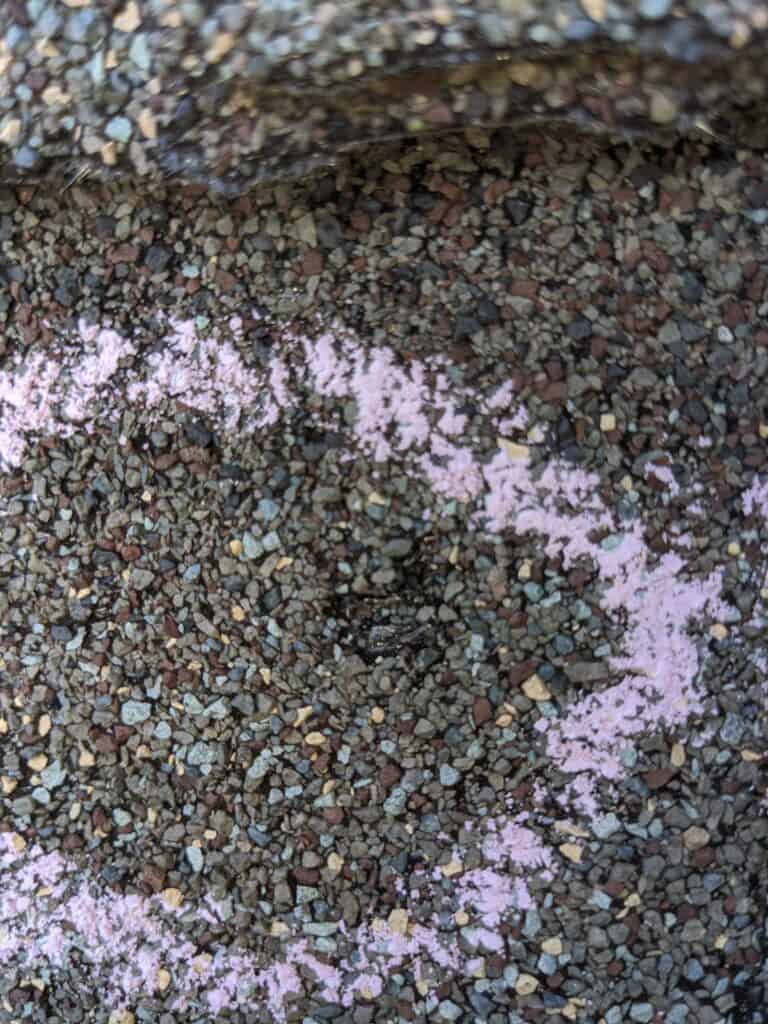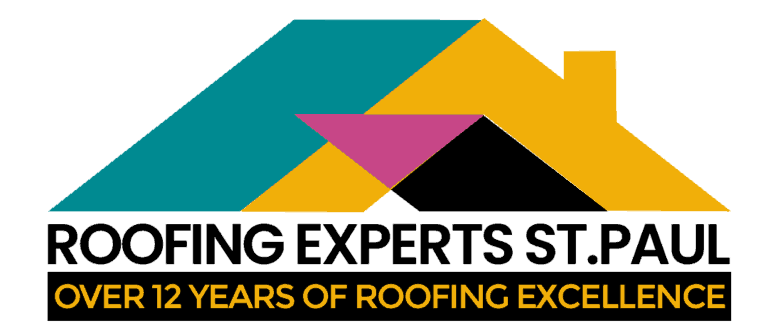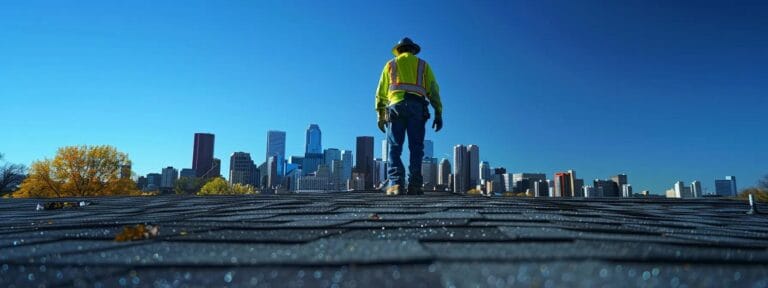Homeowners insurance can cover roof damage, contingent upon the policy's specific provisions. Generally, damage from windstorms, hail, lightning, and fire is covered, as are accidents like falling objects. However, wear and tear, neglect, and aging materials are typically excluded. Accurate documentation and prompt reporting are crucial when filing a claim. Claims can impact your premiums, especially if frequent or high-value. Preventive measures, such as regular inspections and maintenance, can mitigate risks and support claims. Understanding both policy conditions and preventive strategies is vital for securing adequate coverage. Discover comprehensive insights into ensuring your roof's protection and your financial peace of mind.
Understanding Roof Damage Coverage
- Roof damage from perils like windstorms, hail, lightning, and fire is typically covered by insurance.
- Accidental incidents, such as falling objects, are usually included in standard insurance policies.
- Wear and tear or damage from lack of maintenance are generally excluded from coverage.
- Documenting damage with photos and written descriptions aids in filing successful claims.
- Understanding policy-specific conditions is crucial for knowing coverage limitations and exclusions.
Types of Roof Damage
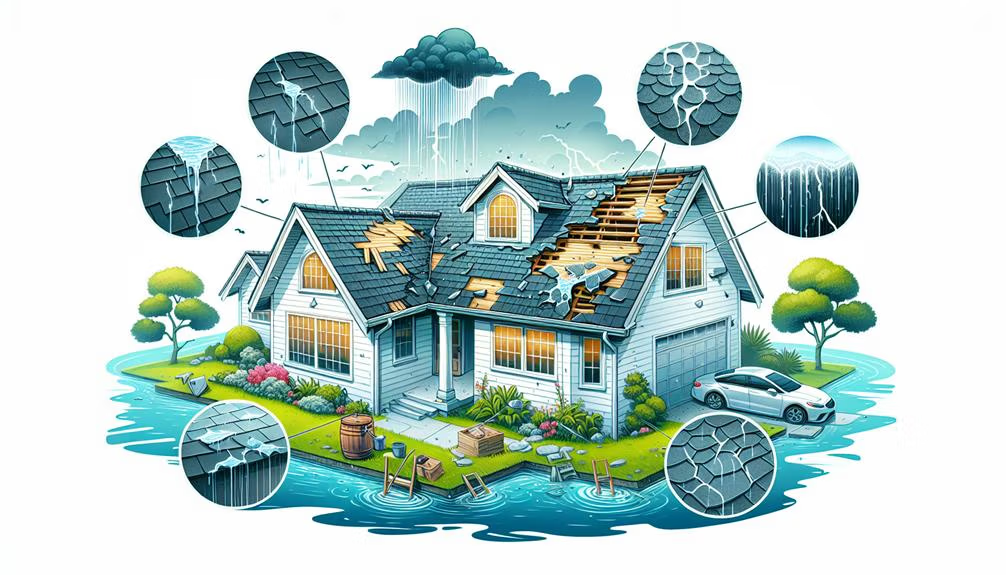
Roof damage can manifest in various forms, each with its own implications for structural integrity and insurance coverage. Common types of roof damage include leaks, punctures, and shingle deterioration. Leaks often result from poor installation or aging materials, allowing water to penetrate the roofing system and potentially damage the underlying structure. Punctures, typically caused by falling debris or severe weather events, can compromise the roof's protective barrier, leading to further degradation if not promptly addressed.
Additionally, shingle deterioration is prevalent in older roofs where weathering effects such as UV radiation, wind, and rain gradually erode the materials. This deterioration can lead to curling, cracking, or complete loss of shingles, thereby reducing the roof's efficacy in safeguarding the home. Another critical form of damage is structural sagging, which arises from prolonged exposure to moisture or excessive load, posing significant risks to the roof's integrity and the safety of the inhabitants.
Understanding these types of roof damage is crucial for homeowners, as it informs both preventive maintenance strategies and the scope of potential insurance claims. Each form of damage demands specific attention and remediation efforts to ensure the longevity and reliability of the roofing system.
Covered Perils
Insurance policies often specify a range of perils that are covered in the event of roof damage, providing homeowners with a clear understanding of their protection scope. Commonly covered perils typically include natural disasters such as windstorms, hail, lightning strikes, and fire. These events are often explicitly listed within the policy to ensure that homeowners can anticipate the types of scenarios for which they are financially protected.
In addition to natural disasters, most standard homeowners' insurance policies also cover damage resulting from accidental incidences such as falling objects. For instance, if a tree branch falls onto the roof during a storm, causing significant damage, this would generally be covered under the policy. Water damage resulting specifically from rainstorms might also be included, provided it meets certain conditions stipulated in the coverage terms.
Moreover, vandalism and malicious mischief, although less common, are perils that can be covered, ensuring that homeowners are safeguarded against intentional damage to their property. It's important to meticulously review the terms, as each policy may outline unique conditions and exceptions. Understanding these covered perils enables homeowners to take proactive measures in securing their homes and ensuring they have adequate insurance coverage.
Exclusions and Limitations
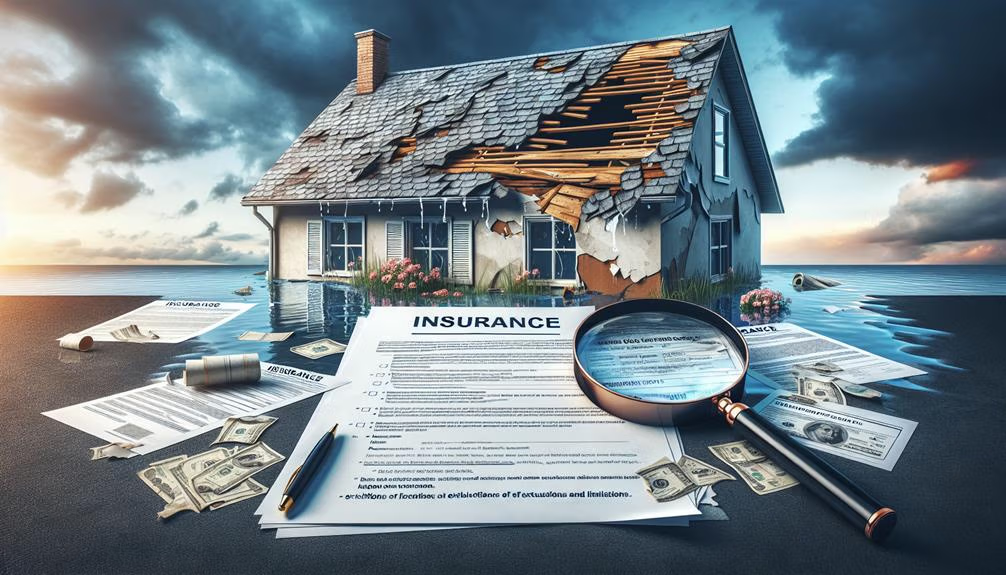
When considering roof damage coverage, it is essential to understand the exclusions and limitations inherent in most insurance policies. Typically, wear and tear are not covered, emphasizing the importance of routine maintenance. Additionally, policy-specific conditions may impose further restrictions, which require careful review to ensure comprehensive protection.
Wear and Tear
Understanding the exclusions and limitations related to wear and tear is essential for policyholders seeking comprehensive roof damage coverage. Insurance policies typically distinguish between sudden, accidental damage and gradual deterioration resulting from normal aging. Most standard homeowners' insurance policies exclude coverage for damage that arises from wear and tear, as it is deemed a predictable outcome of the material's lifespan and environmental exposure.
This exclusion means that if your roof's shingles deteriorate over time or if leaks develop due to prolonged exposure to the elements, the associated repair costs will likely fall on the homeowner. The rationale behind this exclusion is grounded in the principle that maintenance is the homeowner's responsibility, and insurance is designed to cover unforeseen events rather than inevitable degradation.
Policyholders should be vigilant in maintaining their roofs to avoid significant out-of-pocket costs. Regular inspections and timely repairs can mitigate the risks associated with wear and tear. Additionally, some insurers offer endorsements or additional coverage options that can provide a buffer against such exclusions, albeit typically at an increased premium. Understanding these policy nuances is crucial for making informed decisions about your insurance coverage and maintenance strategies.
Policy Specific Conditions
Frequently, homeowners' insurance policies contain specific conditions that delineate exclusions and limitations related to roof damage coverage. These conditions are crucial in understanding whether a claim for roof damage will be honored. Typically, policies exclude coverage for damage resulting from wear and tear, neglect, or lack of maintenance. For instance, if a roof has not been properly maintained and suffers damage due to gradual deterioration, such claims are often not covered.
Exclusions also apply to damage caused by specific perils not covered under the policy, such as earthquakes or floods, unless additional riders are purchased. Additionally, limitations may be imposed on the amount payable for certain types of roof damage. For example, if a policy includes actual cash value coverage instead of replacement cost coverage, the payout may be significantly lower due to depreciation.
Furthermore, some policies stipulate that only roofs under a certain age are eligible for full replacement costs, while older roofs may only receive depreciated value. Understanding these exclusions and limitations is essential for homeowners to ensure they have adequate coverage and to avoid unexpected financial burdens in the event of roof damage.
Filing a Claim
Initiating a roof damage claim with your insurance provider requires careful documentation and adherence to policy guidelines. Detailed records and a clear understanding of your policy will streamline the process, ensuring that your claim is processed efficiently and effectively. Begin by thoroughly documenting the damage through photographs and written descriptions, capturing the extent and nature of the roof damage from multiple angles. This visual and written evidence will substantiate your claim.
Next, notify your insurance company as soon as possible. Prompt communication is crucial, as delays can complicate the claim process. Contact your insurer's claims department and provide them with all necessary information, including your policy number, dates, and details of the damage.
Here are some critical steps to make the process smoother:
- Gather Evidence: Take clear, dated photos and videos of the damage to present a compelling case.
- Keep Receipts: Maintain records of any temporary repairs or related expenses incurred to prevent further damage.
- Consult Professionals: Engage a licensed roof inspector or contractor to provide an expert assessment and detailed report of the damage.
Impact on Premiums
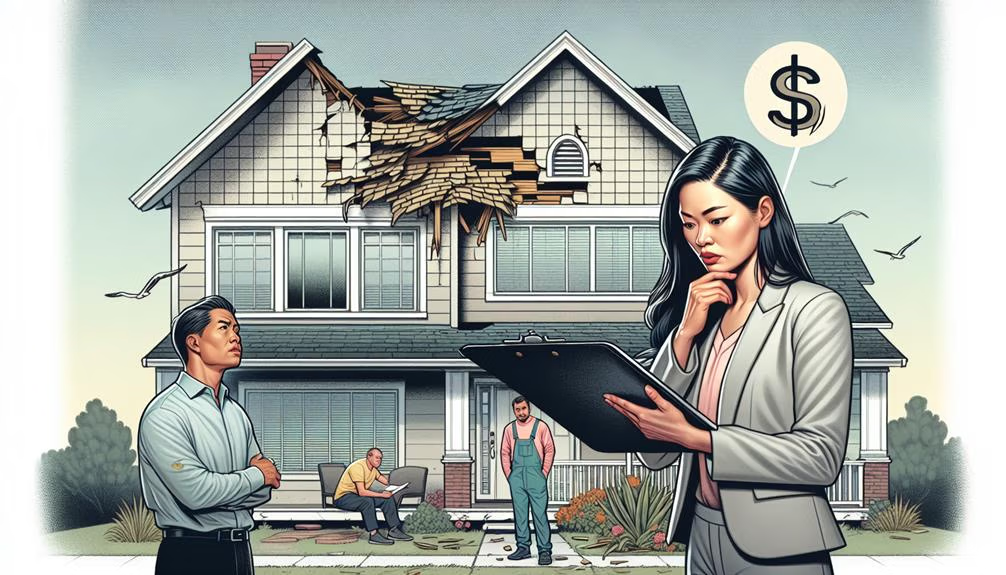
When considering roof damage coverage, it is crucial to understand how filing a claim can influence your insurance premiums. Several factors, including the number and severity of claims made, play a significant role in determining premium adjustments. Moreover, the type of roof and its condition can further impact the extent of any premium increases.
Claims Affecting Premiums
Filing a claim for roof damage can significantly influence the cost of your insurance premiums. When a claim is made, insurance companies assess the risk associated with insuring your property. A history of claims can indicate a higher probability of future claims, which may lead to increased premiums. Insurers aim to mitigate risk, and one way they achieve this is by adjusting premiums based on claim history.
While it is essential to report substantial damage to ensure your property is protected and repaired, it is also crucial to be aware of the potential financial implications. Frequent claims can lead to higher premiums, making it important to consider the necessity and impact of each claim.
Here are some key considerations to keep in mind:
- Frequency of Claims: Multiple claims within a short period can signal higher risk to insurers, leading to elevated premiums.
- Claim Amount: Larger claim amounts can have a more significant impact on your premium adjustments.
- Insurance Policy Terms: Some policies offer claim forgiveness or have specific terms that may affect how claims influence premiums.
Understanding these factors can help you make informed decisions about filing claims for roof damage and managing your insurance costs effectively.
Premium Increase Factors
A variety of factors can contribute to the increase in insurance premiums following a roof damage claim. One of the primary determinants is the frequency of claims; policyholders who have filed multiple claims in a short span are often deemed higher risk, prompting insurers to raise premiums. Additionally, the extent and cost of the roof damage play crucial roles. Significant damages requiring substantial payouts are likely to result in higher premium adjustments.
The age and condition of the roof prior to the damage also influence premium changes. Older roofs or those that were not adequately maintained are more susceptible to damage, leading insurers to factor in the increased likelihood of future claims. Geographic location is another pivotal element; areas prone to severe weather conditions, such as hurricanes or hailstorms, often see higher premium rates as insurers account for the increased risk of weather-related damage.
Lastly, the overall claims history in the region can impact premiums. If an area has experienced a surge in claims due to a recent natural disaster, insurers might adjust premiums for all policyholders in that region to mitigate potential future losses. Understanding these factors can help homeowners anticipate possible changes in their insurance costs.
Documentation Tips
Ensuring meticulous documentation is crucial for a successful roof damage insurance claim. Accurate and comprehensive records can significantly enhance your chances of receiving adequate compensation. By providing detailed evidence, you can substantiate your claim and navigate the often intricate insurance process more smoothly. Here are some essential documentation tips to consider:
- Photographic Evidence: Take clear, high-resolution photos of the damage. Capture images from multiple angles and include close-ups to highlight specific issues. It's advisable to document the condition of your roof periodically, ensuring you have "before" and "after" photos for comparison.
- Detailed Written Descriptions: Complement your photographic evidence with thorough written descriptions. Include information on the extent of the damage, the suspected cause (e.g., hailstorm, wind), and any immediate steps taken to mitigate further harm. Providing a narrative can help insurance adjusters understand the context of the damage.
- Professional Assessments: Obtain evaluations from certified roofing contractors or inspectors. Their expert opinions can lend credibility to your claim, offering an unbiased assessment of the damage and projected repair costs. Ensure these assessments are well-documented and include detailed reports, estimates, and contact information.
Preventive Measures

Implementing preventive measures can significantly reduce the risk of roof damage and help maintain the structural integrity of your home. Regular inspections are paramount; homeowners should conduct biannual roof assessments, ideally in spring and fall, to identify and address potential issues such as loose shingles, leaks, or accumulated debris. Engaging a professional roofing contractor for these inspections ensures a thorough evaluation, potentially uncovering problems that might be overlooked by an untrained eye.
Proper maintenance is equally crucial. Cleaning gutters and downspouts prevents water build-up that can lead to leaks and structural damage. Additionally, trimming overhanging tree branches reduces the risk of impact damage from falling limbs during storms. Ensuring adequate attic ventilation also helps in maintaining the roof's longevity by preventing moisture accumulation and condensation, which can cause mold and rot.
Investing in high-quality roofing materials that are designed to withstand local weather conditions can further mitigate damage risks. For instance, impact-resistant shingles are recommended in hail-prone regions, while materials with high wind resistance are advisable in hurricane-prone areas. By implementing these preventive measures, homeowners not only safeguard their property but also enhance the likelihood of favorable outcomes when filing insurance claims for roof damage.
Frequently Asked Questions
How Often Should I Inspect My Roof for Potential Damage?
It is advisable to inspect your roof for potential damage at least twice a year, ideally during the spring and fall. Additionally, inspections should be conducted following any severe weather events, such as heavy rain, windstorms, or hail. Regular inspections help identify and address minor issues before they escalate into significant problems, thereby ensuring the longevity and structural integrity of your roof.
What Are the Signs of Roof Damage I Should Look For?
Imagine your roof as the first line of defense in a fortress; any breach can compromise safety. Key signs of roof damage include missing or curling shingles, granules in gutters, and water stains on ceilings. Additionally, look for sagging areas and moss or algae growth. Regular inspections can reveal these issues early, much like a vigilant guard spotting intruders, thus preventing extensive and costly damage.
Can I Choose My Own Roofing Contractor for Repairs?
Yes, policyholders generally have the freedom to select their own roofing contractor for repairs. However, it is advisable to first review your insurance policy and consult with your insurance provider to ensure compliance with any specific requirements or guidelines. It is also recommended to choose a licensed and insured contractor to avoid potential issues and ensure quality workmanship that aligns with insurance standards.
How Long Does the Claims Process Typically Take?
Imagine a marathon runner pacing through a race; similarly, the insurance claims process for roof damage requires patience and endurance. Typically, the claims process can take anywhere from a few weeks to several months to complete. The duration depends on various factors such as the complexity of the damage, the efficiency of the insurance company, and the documentation provided by the claimant. Prompt and thorough communication can expedite this process.
Will My Insurance Cover Roof Damage From a Previous Owner?
Insurance coverage for roof damage from a previous owner largely depends on the specific terms of your policy and when the damage occurred. Most standard homeowner's insurance policies cover only sudden and accidental damage, not pre-existing conditions. It is advisable to review your policy details and consult with your insurance provider to determine the extent of coverage available for such situations.
Conclusion
The intricacies of roof damage insurance coverage reflect a nuanced interplay between policy terms and homeowner responsibilities. Notably, approximately 40% of homeowner insurance claims are related to wind and hail damage, underscoring the prevalence of such perils. Understanding covered perils, exclusions, and the claim process is essential for homeowners seeking to mitigate financial loss. Comprehensive documentation and preventive measures further fortify one's position, potentially impacting premiums favorably while ensuring adequate coverage and protection against unforeseen circumstances.


